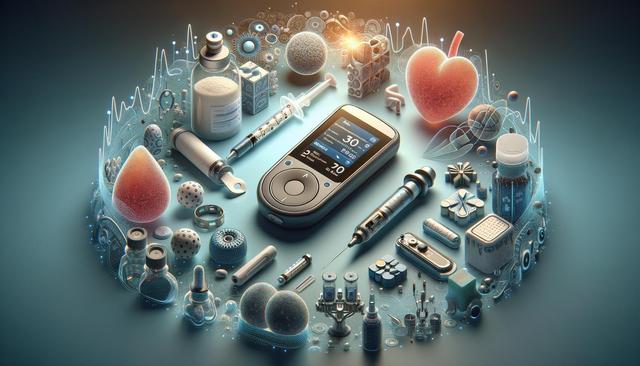
Discover the Latest Innovations in Type 2 Diabetes Technology
Advancements in Continuous Glucose Monitoring
Continuous glucose monitoring (CGM) has become one of the most notable breakthroughs in Type 2 Diabetes Technology. Unlike traditional finger-prick methods, CGM Type 2 Diabetes systems offer real-time data on glucose levels throughout the day and night. These devices use small sensors inserted under the skin to track glucose trends, which can be viewed through a smartphone or dedicated reader. This data allows individuals to make informed decisions about diet, exercise, and medication timing. The growing Clinical Use of Continuous Glucose Monitoring in Adults with Type 2 Diabetes has shown promising results in improving glycemic control and reducing the risk of complications.
Wearable blood sugar monitors, as part of CGM systems, contribute to greater convenience and user engagement. These technologies provide alerts for high or low glucose levels, which helps prevent emergencies and supports proactive management. Healthcare providers can also use the data to adjust treatment plans more effectively, creating a collaborative approach to care.
Smart Insulin Delivery and Connected Devices
Smart insulin pens and connected insulin delivery systems are revolutionizing how insulin is administered. These devices not only track insulin doses but also sync with apps to provide reminders, dosage history, and integration with glucose readings. This integration enables users to align their insulin usage with glucose trends, reducing the chances of missed doses or incorrect timing.
Combining smart insulin delivery systems with a Blood Glucose Monitoring Device offers a comprehensive management toolkit. Users benefit from:
- Improved dosing accuracy
- Data-driven insights for healthcare providers
- Greater adherence to treatment plans
These innovations are especially useful for individuals managing multiple medications or those needing support to stay consistent with their care routines.
The Role of Artificial Intelligence in Diabetes Management
Artificial intelligence (AI) is increasingly being integrated into Type 2 Diabetes Technology to enhance personalized care. AI-powered platforms analyze large volumes of health data to identify patterns, predict glucose fluctuations, and suggest lifestyle adjustments. These tools are particularly helpful for tailoring recommendations to individual behaviors and health goals.
Self Monitoring of Blood Glucose in Type 2 Diabetes can be enhanced through AI by:
- Generating personalized trend reports
- Learning from user inputs to improve predictions
- Offering educational prompts for better self-care
As AI capabilities evolve, they are expected to play an even more significant role in preventive care, potentially identifying risk factors before complications arise.
Integration with Mobile Health Applications
Mobile health applications are central to modern diabetes care. These apps sync with devices like a Blood Glucose Monitoring Device or a Wearable Blood Sugar Monitor to consolidate data in one place. Users can view trends, set reminders, and even share information with healthcare professionals directly from their smartphones.
These applications often include features such as:
- Meal tracking and carbohydrate counting
- Exercise logging with glucose impact analysis
- Medication reminders and refill alerts
By supporting consistent tracking and lifestyle management, mobile apps empower users to take a more active role in their diabetes care.
Future Directions in Type 2 Diabetes Technology
The future of Type 2 Diabetes Technology is promising, with ongoing research focused on non-invasive monitoring and closed-loop insulin delivery systems. Innovations aim to reduce the physical and mental burden of diabetes care while improving accuracy and ease of use. For example, upcoming Blood Glucose Monitoring Devices may eliminate the need for skin pricks altogether, offering completely non-invasive alternatives.
As these technologies become more accessible, they have the potential to benefit a broader population, including those in underserved communities. The increasing Clinical Use of Continuous Glucose Monitoring in Adults with Type 2 Diabetes reflects a growing recognition of these tools’ value in routine care.
Educating users about the benefits and proper use of these technologies will be essential to maximizing their impact. Both individuals and healthcare providers should stay informed about new tools to ensure effective and up-to-date diabetes management strategies.
Conclusion: Empowering Individuals Through Innovation
Staying informed about new developments in Type 2 Diabetes Technology can significantly improve how individuals manage their condition. From CGM Type 2 Diabetes tools to AI-driven platforms and smart insulin delivery, each innovation offers unique benefits that support personalized care. The integration of devices like a Wearable Blood Sugar Monitor and mobile apps encourages consistency, while the Clinical Use of Continuous Glucose Monitoring in Adults with Type 2 Diabetes continues to demonstrate improved outcomes. By leveraging these tools, individuals and caregivers can make more informed decisions, ultimately leading to better quality of life and more effective long-term management.


